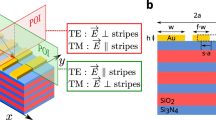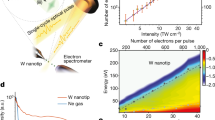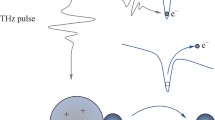Abstract
An amplitude-modulated laser, in the presence of a static magnetic field, interacts with an array of carbon nanotubes embedded on a metallic surface. The laser exerts a ponderomotive force on the free electrons of carbon nanotubes at twice the modulation frequency that falls in the terahertz (THz) range. Each nanotube acts as an oscillatory electric dipole, producing THz radiations. The presence of magnetic field shifts the resonance condition and provides tunability. The THz radiation power increases with magnetic field strength.
Similar content being viewed by others
Findings
Background
Over the last decade, there has been significant research activity in the area of terahertz (THz) radiation generation and detection. The THz region of the electromagnetic spectrum lies in the gap between microwaves and infrared with a frequency range of 0.1 to 10 THz and corresponding wavelength range of 30 to 3,000 μm. THz radiations have applications in defense, medical imaging, sensors, spectroscopy, etc. THz radiations can be generated via several mechanisms, viz. optical rectification of a short pulse laser or a surface plasma wave, photoconduction, Cherenkov radiation, etc.[1–9]. Presently, there is an increased interest in employing metallic nanostructures and carbon nanotubes to generate THz radiations as these structures offer the advantage of compactness with reasonable efficiency. A metallic nanostructured surface has been employed by Welsh and Wyne[10] to generate ultrafast THz radiation pulses via excitation of surface plasmon. Garwe et al.[11] have observed THz radiations on either side of a gold-coated nanograting (500 nm), employing a 785-mm, 150-ps, 1-KHz Ti:sapphire laser. Studies on nanoscale periodic arrays of rectangular-shaped holes revealed band formation of THz nanoresonators[12]. Nemilentsau et al.[13] have investigated the application of a finite-length isolated carbon nanotube as a thermal nanoscale antenna in THz range. Batrakev et al.[14] and Portnoi et al.[15] have given elegant reviews of terahertz processes in carbon nanotubes. Another promising scheme of THz radiation generation is by exploiting excellent metallic properties of carbon nanotubes[16]. Wang and Wu[17] have experimentally studied the properties of THz radiation pulses emitted by a metallic, large-aspect ratio carbon nanotube antenna. Ramakrishnan et al.[18] have observed generation of a sub-picosecond THz pulse by illuminating a graphite surface with femtosecond infrared laser pulses. Dragoman and Dragoman[19] have given the physical model and simulation results of semiconducting carbon nanotube resonant-tunneling diodes for THz radiation generation. Zhao et al.[19] have studied the characteristics of metallic, single-walled carbon nanotubes as THz antenna. Wang et al.[20] have observed antenna-like effect in an array of aligned carbon nanotubes. Dagher et al.[21] have studied amplification of radiation in metallic carbon nanotubes under the influence of a d.c. magnetic field. Parashar and Sharma[22] have studied THz radiation generation via optical rectification of a laser in an array of carbon nanotubes. In this work, we extend their work to study the effect of static magnetic field on THz radiation generation from an array of carbon nanotubes. An amplitude-modulated laser interacts with an array of cylindrical carbon nanotubes. The laser exerts a ponderomotive force on the free electrons on the nanotubes, inducing on them a current at twice the modulation frequency. The image charges in the metallic base constitute a supplementary array with currents out of phase by π with respect to the primary array. These oscillating nanotube arrays act as antennas to produce THz radiation.
Analysis
Consider a metal surface (x = 0), embedded with normally mounted carbon nanotubes of radius rc, length ℓc, and surface density Nc (per unit area), where ℓc >> rc. The free electron density inside a nanotube is n0c.f. Figure1.
An amplitude-modulated laser is impinged on the nanotube array with electric and magnetic fields
where k = ω/c, μ is the modulation index of laser, and Ω is in terahertz range.
There also exists a static magnetic field given by
Under the influence of electric field, the electrons of nanotubes are displaced by a distance Δ, and the displacement is governed by the equation of motion
Here, ωp = (no e2/m ε0 )1/2 is the plasma frequency of electrons in a nanotube, −e and m are the charge and effective mass of the electron, ε0 is the free space permittivity, and εL is the relative permittivity of the lattice.
The x and y components of the equation of motion can be written as
and
where
Here, it is to be mentioned that the restoring force due to the displacement of the electron cloud of nanotubes is finite for the field perpendicular to the nanotube axis and zero for the field along the axis.
On simplifying Equations 5 and 6, we obtain the x and y components for the displacement of the electron cloud as
and
respectively.
The electron velocity can be written as
The laser exerts a ponderomotive force on electrons at the modulation frequency
The oscillatory velocity of electrons due to the ponderomotive force following Equation 5 can be written as
The current density at Ω can be written as
is finite over the cross section π rc2 of a nanotube and zero over the area a2 = 1/N (where a is the separation between the nanotubes). Thus, the average terahertz current density due to the array is
where
As the base of the carbon nanotube is metallic, there will be an image current density underneath the metal surface,
Let the y and z dimensions of the array be L × L.
The vector potential at a far point due to the current distributions is
where = r – sinθ cosφ x′ − sinθ sinφ y′ − cosθ z′; r, θ, and φ are the spherical polar coordinates of the point of observation, and we shall assume Ωℓc/c, Ω rc/c <<1 The above Equation 15 can be written as
where
On carrying out integration, I1 and I2 reduce to
and
respectively.
From Equations 17 and 18, we obtain
The magnetic field at far distance is
The time-average Poynting vector using Equation 20 can be written as
In Figure2, we have shown the variation of |r2 Sav| with ωc/Ω at different values of θ for the following set of parameters: ωc/Ω = 20, nanotube radius rc = 25 nm, μ = 0.01, inter-nanotube separation a = 30 nm, length of nanotube ℓc = 500 nm[20], n0 = 1021 cm−3, φ =1 rad, εL = 16, L × L = 2 × 2 cm, and eAL/mωc = 0.03. The efficiency of the generated THz power shows a maximum near θ = 1 rad. The efficiency increases with magnetic field strength, and for the above-mentioned parameters, ωc/Ω = 0.1 corresponds to a magnetic field strength of 100 kG. The above parameter of eAL/mωc = 0.03 can be realized using a Nd:YAG laser of 1.06 μm with an intensity of 1015 W/cm2. In Figure3, we have shown the variation of |r2 Sav| with ωc/Ω at different values of φ for θ = 1 rad. The other parameters are similar to those of Figure2. The power radiated shows oscillatory behavior with φ.
Variation of | r2 S av | with ω c /Ω at different values of φ for θ = 1 rad. Other parameters are similar to those of Figure2.
Conclusions
An array of carbon nanotubes mounted on a metallic base can be employed to generate THz radiations. The radiations' pattern is directional with a peak value of power radiated at around 5 μW, which is quite reasonable. Wang et al.[16] have predicted a maximum efficiency of 5 μW for THz radiations from the armchair carbon nanotube dipole antenna. On comparing with THz radiation generation from a GaP crystal via the difference frequency generation scheme[3], the efficiency is quite good. One can exploit the resonance condition for enhancement of efficiency of THz radiation generation. The application of magnetic field reduces the requirement on the resonance condition. The efficiency of THz radiation increases with the strength of the applied magnetic field. The analysis is limited to a laser of moderate powers only.
Author's information
SJ did his masters degree in Physics from Barkatullah University, Bhopal (M.P.), India, and at present, he is working towards his Ph.D. degree in Physics. His research interests are in the area of interaction of electromagnetic and electrostatic waves with nanoparticles and nanotubes.
JP is presently the head of the Department of Applied Physics at Samrat Ashok Technological Institute. He did his masters in Physics in 1991 and Ph.D. in 1994 from Barkatullah University, Bhopal (M.P.), India. He worked at I.I.T. Delhi, University of Durban, S.A. and National Central University, Taiwan. His research interests include nonlinear effects in laser matter interaction, plasma physics, and free electron lasers.
RK is currently working as an associate professor at Maulana Azad National Institute of Technology, Bhopal (M.P.), India. He has obtained his masters degree in 1991 from Barkatullah University, Bhopal (M.P.), India and doctoral degree from the University of Leeds (UK) in 1998. In 2011, he has received the Royal Academy of Engineering, London, UK, Research Exchange Award for collaborative research with the University of Bath, UK and also received the UK-India Education Research Initiative (UKIERI phase-II) Award under the Thematic Partnership from British Council Delhi for collaborative research with the University of Bath, UK. His current research interests are ferrite nanoparticles and graphene nanoribbons.
References
Chan WL, Deibel J, Mittleman DM: Imaging with terahertz radiation. Rep. Prog. Phys. 2007, 70: 1325–1379. 10.1088/0034-4885/70/8/R02
Bhasin L, Tripathi VK: Resonant terahertz generation by optical rectification of an amplitude modulated surface plasma wave. IEEE J. Quant. Electron. 2010, 46: 965–969. 10.1109/JQE.2010.2041898
Ding YJ: High-power tunable terahertz sources based on parametric processes and applications. IEEE J. Sel. Top. Quantum Electron. 2007, 13: 705–720.
Suizu K, Koketsu K, Shibuya T, Tsutsui T, Akiba T, Kawase K: Extremely frequency-widened terahertz wave generation using Cherenkov-type radiation. Opt. Express 2009, 17: 6676–6681. 10.1364/OE.17.006676
Bhasin L, Tripathi VK: Terahertz generation via optical rectification of x-mode laser in a rippled density magnetized plasma. Phys. Plasmas 2009, 16: 103105. 10.1063/1.3248303
Khoury J, Saeed BH, Buchwald W, Woods C, Wentzell S, Krejca B, Kierstead J: Electrically tunable surface plasmon source for terahertz applications. IEEE J Selected Topics Quant. Electron. 2011, 17: 138–145. 10.1109/JSTQE.2010.2049255
Wynw K, Carey JJ: An integrated description of terahertz generation through optical rectification, charge transfer, and current surge. Optics Communications 2005, 256: 400–413. 10.1016/j.opticom.2005.06.065
Son JH: Terahertz electromagnetic interactions with biological matter and their applications. J. Appl. Phys. 2009, 105: 10203. 10.1063/1.3116140
Hoffman MC, Fülöp A: Intense ultrashort terahertz pulses: generation and applications. J. Phys. D: Appl. Phys. 2011, 44: 083001. 10.1088/0953-4075/44/8/083001
Welsh GH, Wyne K: Generation of ultrafast terahertz radiation pulses on metallic nanostructured surfaces. Opt. Express 2009, 17: 2470–2480. 10.1364/OE.17.002470
Garwe F, Schmidt A, Zieger G, May T, Wyne K, Hübner U, Zeisberger M, Paa W, Stafast H, Meyer HG: Bi-directional terahertz emission from gold-coated nanoratings by excitation via femtosecond laser pulses. Appl. Phys. B 2011, 102: 551–554. 10.1007/00340-011-4377-7
Bahk YM, Park HR, Ahn KJ, Kim HS, Ahn YH, Kim DS, Abad JB, Moreno LM, Vidal FJG: Anomalous band formation in arrays of terahertz nanoresonators. Phys. Rev. Lett. 2011, 106: 013902. 10.1103/PhysRevLett. 106.013902
Nemilentsau AM, Slepyan GV, Maksimenko SA: Thermal radiation from carbon nanotubes in the terahertz range. Phys. Rev. Lett. 2007, 99: 147403. 10.1103/PhysRevLett. 99.147403
Batrakov KG, Kibis OV, Kuzhir PP, de Costa MR, Portnoi ME: Terahertz process in carbon nanotubes. J. Nanophotonics 2010, 4: 041665. 10.1117/1.3436585
Portnoi ME: Kibis, OV, deCosta. MR: Terahertz applications of carbon nanotubes. Superlattices and Microstructures 2008, 43: 399–407. 10.1016/j/spmi.2007.07.026
Wang Y, Wy Q, He X, Zhang S, Zhuang L: Terahertz radiation from armchair carbon nanotube dipole antenna. Chin. Phys. B 2009, 18: 1801–1806. 10.1088/1674-1056/18/5/014
Wang Y, Wu Q: Properties of terahertz wave generated by the metallic carbon nanotube antenna. Chin. Opt. Lett. 2008, 8: 770–772.
Ramakrishnan G, Chakkittakandy R, Paul CMP: Terahertz generation from graphite. Opt. Exp. 2009, 17: 16092–16098. 10.1364/OE.17.016092
Dragoman D, Dragoman M: Terahertz oscillations in semiconducting carbon nanotube resonant tunneling diodes. Physica E 2004, 24: 282–289. 10.1016/j.physe.2004.05.001
Wang Y, Kempa K, Kimball B, Carlson JP, Benham G, Li WZ, Kempa T: Rybczynski, Herczynski A. Ren ZF: Receiving and transmitting light like radiowaves: antenna effect in arrays of aligned carbon nanotubes. Appl. Phys. Lett. 2004, 85: 2607–2609.
Dagher M, Chamanara N, Sounas D, Martel R, Caloz C: Theoretical investigation of traveling wave amplification in metallic carbon nanotubes biased by a dc field. IEEE Trans. Nanotech. 2012, 11: 463–471. 10.1109/TNANO.2011.2175005
Parashar J, Sharma H: Optical rectification in a carbon nanotube array and terahertz radiation generation. Physica E 2012, 44: 2069–2071. 10.1016/j.physe.2012.06.013
Acknowledgement
This work was supported by the University Grants Commission, New Delhi, India under the research award scheme.
Author information
Authors and Affiliations
Corresponding author
Additional information
Competing interests
The authors declare that they have no competing interests.
Authors' contributions
SJ did the numerical analysis part of the work. JP did the analytical part of the work. RK conceived the idea and helped in designing and drafting the manuscript. All authors read and approved the final manuscript.
Authors’ original submitted files for images
Below are the links to the authors’ original submitted files for images.
Rights and permissions
Open Access This article is distributed under the terms of the Creative Commons Attribution 2.0 International License (https://creativecommons.org/licenses/by/2.0), which permits unrestricted use, distribution, and reproduction in any medium, provided the original work is properly cited.
About this article
Cite this article
Jain, S., Parashar, J. & Kurchania, R. Effect of magnetic field on terahertz generation via laser interaction with a carbon nanotube array. Int Nano Lett 3, 1 (2013). https://doi.org/10.1186/2228-5326-3-1
Received:
Accepted:
Published:
DOI: https://doi.org/10.1186/2228-5326-3-1







